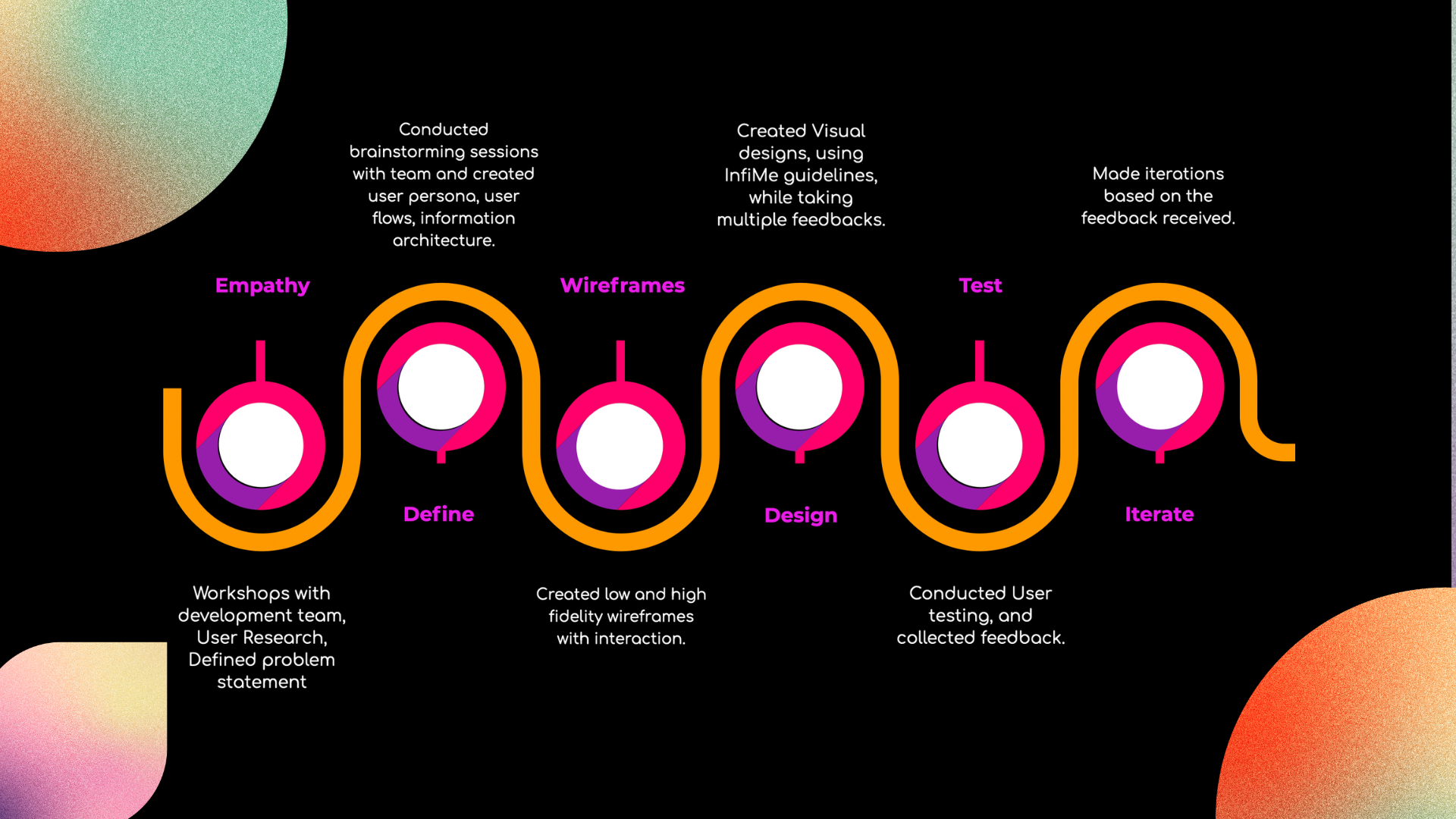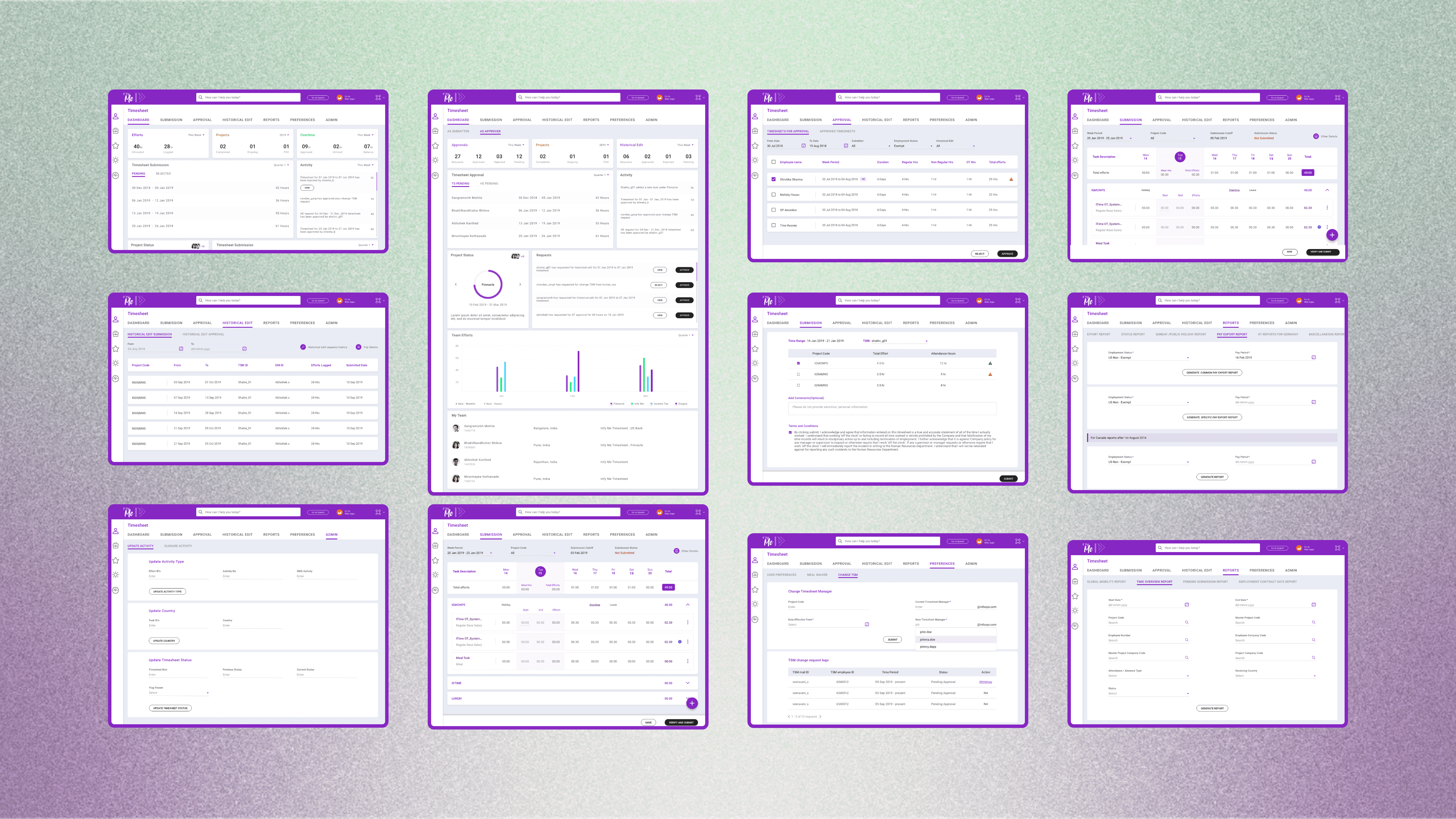Time Sheet
Project Summary
The Infosys Timesheet project aimed to unify three separate time-tracking applications into a single, user-friendly platform. This redesign improved usability, incorporated new features, and enhanced efficiency, all within the project’s tight timeline.
Timeline
December 2019 - February 2020
My Role
Research, Wifreframing, Interaction and visual design
Team Size
4
Abstract
Infosys’s Timesheet application, used by 42,700 employees, streamlined the time-tracking process and saved significant time previously lost to manual formalities. The project aimed to create a unified, user-friendly digital application that enhances staff performance tracking against projects and tasks. Over 12 weeks, we conducted workshops to understand the existing system and redesigned the responsive web application.
Problem Statement
Infosys employees used three variants of the Timesheet application:
-
ITime for US employees
-
Timesheet for Indian employees
-
Timesheet for RoW (Rest of World) employees
Each variant had its own ecosystem with an outdated user interface, causing usability issues. The interactions were cumbersome, and the system had low operability and usage. The challenge was to design a single, uniform experience while keeping the learning curve low for existing users of all three portals.
Objective
The user research uncovered key insights that significantly influenced our user experience design:
-
Unified Design: Follow Infosys’s design guidelines (Infy Me) to create a consistent user experience.
-
Role Integration: Incorporate submitter, approver, and admin roles in a single platform.
-
New Functionalities: Add features such as applying for overtime (OT) and others.
-
Timely Delivery: Complete design and development within three months.
Challenges & Limitations
Time Constraints: Limited period to understand the existing system and iterate new designs.
Design Constraints: To follow the components designed for InfyMe.
User Research Limitations: Time zone differences restricted extensive user research.
Feature Utilization Gap: Discrepancy between required features and actual user needs.
Multiple Iterations: Necessity for several design iterations to refine the application.
Delivery Timeline: Requirement to deliver the responsive web application within three months.

Project Phases
Research and Analysis (4 Weeks):
-
Workshops: Conducted multiple workshops with employees from different regions (US, India, RoW) to understand their specific requirements and pain points with the current timesheet systems.
-
Surveys and Interviews: Distributed surveys and conducted one-on-one interviews to gather detailed feedback on user experiences and preferences.
-
System Analysis: Analyzed the existing systems to identify common functionalities and unique features that need to be retained or improved.
-
User Personas: Developed user personas and use cases to better understand the diverse needs of different user groups (submitters, approvers, and admins).
Design and Prototyping (4 Weeks):
-
Wireframing: Created wireframes to map out the basic structure and flow of the new unified application.
-
Prototyping: Developed interactive prototypes to visualize the design and functionality of the application.
-
User Testing: Conducted usability testing sessions with a diverse group of employees to gather feedback and identify any issues or areas for improvement.
-
Iterative Design: Refined the design based on user feedback, ensuring the interface is intuitive and aligns with Infosys’s design guidelines (Infy Me).
-
Feature Integration: Incorporated new features like overtime application and streamlined processes for submitting and approving timesheets.
Development and Implementation (4 Weeks):
-
Agile Development: Followed an agile development approach, with regular sprints to ensure timely progress and adaptability to feedback.
-
Responsive Design: Ensured the application is fully responsive, providing a seamless experience across various devices (desktops, tablets).
-
Deployment: Deployed the application in a phased manner, starting with pilot groups to monitor performance and gather initial feedback before a full rollout.

0
Active Users
0
User roles
0
Success Metric
Solution
Minimalistic UI: Utilized Infosys’s design guidelines to create a clean, intuitive interface.
Uniform Experience: Ensured a consistent and delightful experience for both submitters and approvers.
Dashboard Introduction: Added a dashboard for quick overviews of projects and pending tasks.
Enhanced Discoverability: Improved access to crucial information such as timesheet status, overtime approvals, and deadlines.
Efficient Processes: Streamlined common tasks to be more intuitive and efficient. Logical Layout: Organized data to reduce visual load and deliver information quickly.
Success Metric
Success metrics for the redesigned Infosys Timesheet application include a 40% reduction in time spent on timesheet submission and approval, a 30% increase in user satisfaction scores, and a 20% boost in active usage rates. Additionally, error rates decreased by 25%, and overall employee productivity saw a significant improvement.
Advantages
For Employees
-
Track Effort/Time Spent: Easily monitor and record the time spent on various tasks and projects, enhancing personal productivity.
-
Earn Extra Credits (OT): Simplified process for applying and tracking overtime, allowing employees to earn extra credits efficiently.
-
Monitoring & Controlling:Improved ability to monitor and control their work hours, ensuring they stay on track with their responsibilities.
-
Task and Hours Overview: Provides a clear overview of tasks and the hours spent on each, helping employees manage their workload effectively.
-
Quick Notifications: Timely notifications for task completion and leave applications, keeping employees informed and organized.
For Infosys:
-
Measure Workload: Accurately measure employee workload to balance tasks and resources efficiently.
-
Bill Clients: Streamlined process for tracking billable hours, ensuring accurate client billing and improving revenue management.
-
Compare Planned vs. Actual Efforts: Enhanced ability to compare planned efforts with actual time spent, identifying discrepancies and areas for improvement.
-
Better Estimates for Future Projects: Improved data accuracy helps in making better estimates for future tasks and projects, enhancing planning and forecasting.
-
Save Money and Time: Reduced administrative overhead and increased efficiency save both money and time for the organization.
-
Better Project Management: Enhanced project management capabilities through improved tracking, monitoring, and reporting features, leading to successful project outcomes.
Conclusion
The successful redesign of the Infosys Timesheet application highlights the importance of user-centric design and iterative development. By addressing usability issues and incorporating new functionalities, we delivered a solution that not only met but exceeded the expectations of Infosys employees, paving the way for more efficient and effective time-tracking processes.